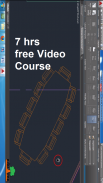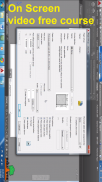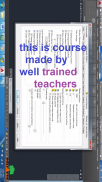









learn free Autocad 2015 - full free video course

Beschreibung von learn free Autocad 2015 - full free video course
AutoCad 2015 Contents
Chapter-1
1. Introduction to AutoCAD 2015.
2. Exploring the user interface.
3. Using the ribbon.
4. Changingworkspaces.
5. Customizing the user interface.
6. Editing command aliases.
Chapter-2
1. Opening, saving, and closing files.
2. Selecting drawing units.
3. Converting drawings to new units.
4. Using and creating templates.
Chapter-3
1. Using commands and panning a drawing.
2. Using the Zoom command to navigate.
3. Saving and restoring views.
Chapter-4
1. Lines.
2. Circles.
3. Arcs.
4. Ellipses.
5. Splines.
6. Polylines.
Chapter-5
1. Selectingobject.
2. Moving and copying command.
3. Rotating and scaling.
4. Trimming and extending.
5. Using the fillet, chamfer, and blend commands.
Chapter-6
1. UsingGridandSnap.
2. Makingisometricdrawings.
3. Understanding coordinate systems
4. Usingpolartracking.
5. Workingwithobjectsnaps.
Chapter-7
1. Engineering project: Part drawing.
2. Architecturalproject: Attachinga sketch.
3. Architecturalproject: Drawingwalls.
4. Architectural project: Cutting openings.
Chapter-8
1. UsingtheHatchcommand.
2. Creatinghatchpatternsbyselectingobjects.
3. Creating gradients.
4. Editing hatch boundaries.
Chapter-9
1. Creating text styles.
2. Writing single-line text.
3. Aligning text objects.
Chapter-10
1. Measuringdistances and areas.
2. Making dimensionobjects.
3. Editing existing dimensions.
4. Editing a dimension style.
5. Creating dimension sub styles.
6. Creatingmultileaders.
Chapter-11
1. Hiding and isolatingobjects.
2. Editing object properties.
3. Creatinglayers.
4. Using the Layer dropdown menu.
5. Saving and restoring layer states.
6. Alteringobjectdisplayorder.
Chapter-12
1. Working with groups.
2. Creating and insertingblocks.
3. Using By Layer and By Block object properties.
4. Redefiningblocks.
5. Accessing external block content.
Chapter-13
1. Designing a symbol with textplaceholders.
2. Creating a table and start to populate its cells with data.
3. Styling a table's title text.
4. Adding fields to tables.
Chapter-14
1. Exportingobjects to a file.
2. Attaching and overlayingx refs.
3. Altering xrefs.
4. Clipping xrefs.
5. Editing xrefs in place.
Chapter-15
1. Create and configure a layout.
2. Configuring a viewport.
3. Lockingviewports.
Chapter-16
1. Packaging your data with e Transmit.
2. Outputting DWFx files for sharing online.
3. Publishingmultiplesheets.</br></br></br></br></br></br></br></br></br></br></br></br></br></br></br></br></br></br></br></br></br></br></br></br></br></br></br></br></br></br></br></br></br></br></br></br></br></br></br></br></br></br></br></br></br></br></br></br></br></br></br></br></br></br></br></br></br></br></br></br></br></br></br></br></br></br></br></br></br></br></br></br></br></br></br></br></br></br></br></br></br></br></br></br></br></br></br></br></br></br></br></br></br></br></br></br></br></br></br></br></br></br></br></br></br>

























